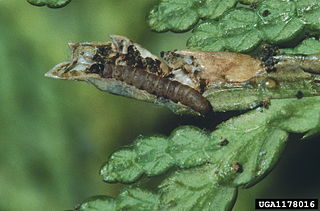
Daphnis nerii, the oleander hawk-moth or army green moth, is a moth of the family Sphingidae. It was described by Carl Linnaeus in his 1758 10th edition of Systema Naturae.
Copticostola is a genus of moths in the family Gelechiidae. It contains the species Copticostola acuminata, which is found in Tabasco, Mexico.

Mythimna irrorata is a moth of the family Noctuidae first described by Frederic Moore in 1881. It is found in the north-western parts of the Himalayas and Sri Lanka.

Coleotechnites thujaella is a moth of the family Gelechiidae. It is found in the north-eastern parts of the United States, as well as Canada.

Zealandopterix zonodoxa is a moth of the family Micropterigidae. It endemic to New Zealand and is found from the Hawkes Bay north as well as on Poor Knights, Little Barrier and Great Barrier Islands. It is the smallest micropterigid in New Zealand and the shiny white markings on the forewing of this species are variable. It is a day flying moth, but has been collected using UV light. Adults are on the wing from September to March and the species has been witnessed visiting the flowers of Nikau and Cordyline pumilio in large numbers. It inhabits a wide variety of moist indigenous forest but is associated with forests in which podocarps are common. Larvae have been sieved from rotten wood on the floor of a mixed podocarp/broadleaf forest or extracted from moss or from bryophytes.

Thisizima fasciaria is a moth of the family Tineidae. It is found in China.

Thisizima subceratella is a moth of the family Tineidae. It is found in China.
Lyonetia probolactis is a moth in the family Lyonetiidae. It is known from Mahé and Silhouette islands in the Seychelles.
Sufetula polystrialis is a moth in the family Crambidae. It was described by George Hampson in 1912. It is found on the Louisiade Islands.

Tyspanodes radiata is a moth in the family Crambidae. It was described by George Hamilton Kenrick in 1907. It is found on New Guinea.
Agonopterix ventrangulata is a moth in the family Depressariidae. It was described by Alexandr L. Lvovsky and Shu-Xia Wang in 2011. It is found in Fujian, China.
Helcystogramma juventellus is a moth in the family Gelechiidae. It was described by Walsingham in 1897. It is found in Jamaica and Mexico (Tabasco).
Hypatima corynetis is a species of moth in the family Gelechiidae. It was described by Edward Meyrick in 1913. It is found in Sri Lanka.
Compsolechia scopulata is a moth of the family Gelechiidae. It was described by Edward Meyrick in 1914. It is found in Guyana and Brazil.
Lecithocera decorosa is a moth in the family Lecithoceridae. It was described by Alexey Diakonoff in 1968. It is found on Luzon in the Philippines.
Philharmonia basinigra is a moth in the family Lecithoceridae. It was described by Wang and Wang in 2015. It is found in China.
Gonionota extima is a moth in the family Depressariidae. It was described by Clarke in 1964. It is found in Costa Rica.
Gonionota fimbriata is a moth in the family Depressariidae. It was described by Clarke in 1964. It is found in Panama.
Gonioterma exquisita is a moth in the family Depressariidae. It was described by W. Donald Duckworth in 1964. It is found in Brazil.
Stenoma sequestra is a moth in the family Depressariidae. It was described by Edward Meyrick in 1918. It is found in the Guianas and Brazil.





